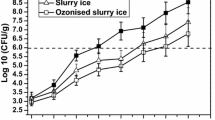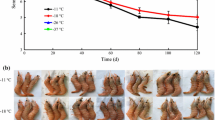Abstract
The use of a combined ozonised-slurry ice system was investigated as a new refrigeration system for the on-board storage of megrim (Lepidorhombus whiffiagonis), a fish species that is usually stored aboard fishing vessels for 1 to 2 weeks. The time elapsed between the catch and unloading at the harbour affects its quality and commercial value directly. Microbiological, chemical and sensory analyses were carried out in megrim after 2 weeks of on-board storage in ozonised slurry ice, slurry ice or flake ice, and for an additional period of 6 days. Sensory analyses revealed that megrim specimens stored in ozonised slurry ice (oSI600 batch) maintained A quality even after 20 days of storage, while counterpart batches stored in flake ice showed B quality at unloading, after 14 days of on-board storage. Storage in ozonised slurry ice (oSI600 batch) also led to significantly (p<0.05) lower counts of aerobic mesophiles, psychrotrophic bacteria, Enterobacteriaceae and proteolytic microorganisms in megrim muscle as compared with flake ice. Biochemical analyses revealed that the use of ozonised-slurry ice or slurry ice alone slowed down the formation of total volatile base-nitrogen (TVB-N) and trimethylamine-nitrogen (TMA-N) in comparison with storage in flake ice, also allowing a better control of pH. Lipid hydrolysis and oxidation events also occurred at a lower rate in the ozonised-slurry ice and slurry ice batches than in the flake ice batch. The present study demonstrates that the combination of slurry ice and ozone for the on-board storage of megrim is advisable, thus improving the quality and extending the shelf life of this fish species.
Similar content being viewed by others
References
Whittle K, Hardy R, Hobbs G (1990) Chilled fish and fishery products. In: Gormley T (ed) Chilled foods: The state of the art. Elsevier Applied Science, New York (USA), pp 87–116
Olafsdöttir G, Martinsdöttir E, Oehlenschläger J, Dalgaard P, Jensen B, Undeland I, Mackie I, Henehan G, Nielsen J, Nilsen H (1997) Trends Food Sci Technol 8:258–265
Nunes M, Batista I, Morâo de Campos R (1992) J Sci Food Agric 59:37–43
Kraus L (1992) Refrigerated sea water treatment of herring and mackerel for human consumption. In: Burt J, Hardy R, Whittle K (eds) Pelagic fish: The resource and its exploitation. Fishing News Books, Aberdeen, Scotland, pp 73–81
Ponce de León S, Inoue N, Shinano H (1993) Bull Fac Fish Hokkaido Univ 44:80–85
Hwang K, Regenstein J (1995) J Aquat Food Prod Technol 4:19–30
Piñeiro C, Barros-Velázquez J, Aubourg SP (2004) Trends Food Sci Technol 15:575–582
Chapman L (1990) Aust Fish 7:16–19
Price RJ, Melvin EF, Bell JW (1991) J Food Sci 56:318–321
Harada K (1991) Aust Fish 2:28–30
Huidobro A, López-Caballero M, Mendes R (2002) Eur Food Res Technol 214:469–475
Campos C, Rodríguez O, Losada V, Aubourg SP, Barros-Velázquez J (2005) Int J Food Microbiol 103:(doi: 10.1016/j.ijfoodmicro.2004.11.039)
Losada V, Barros-Velázquez J, Gallardo JM, Aubourg SP (2004) Eur J Lipid Sci Technol 106:844–850
Campos C, Losada V, Rodríguez O, Aubourg SP, Barros-Velázquez J (in press) Food Chem (doi:10.1016/j.foodchem.2005.03.040)
FAO Inform (2003) Fishery statistics. In: Food and agriculture organization of the United Nations Yearbook 2001, vol 93. FAO, Rome
Baremo de Clasificación de Frescura (1989) In: Diario Oficial de las Comunidades Europeas no L 5/21. European Commission, Brussels, pp 5–6
Ben-Gigirey B, Vieites Baptista de Sousa JM, Villa TG, Barros-Velázquez J (1998) J Food Prot 61:608–615
Ben-Gigirey B, Vieites Baptista de Sousa JM, Villa TG, Barros-Velázquez J (1999) J Food Prot 62:933–939
Phaff HJ, Starmer WT, Lachance MA, Ganter PF (1994) Int J Syst Bacteriol 44:641–645
Ben-Gigirey B, Vieites Baptista de Sousa JM, Villa TG, Barros-Velázquez J (2000) Int J Food Microbiol 57:19–31
Aubourg S, Sotelo C, Gallardo J (1997) J Food Sci 62:295–298, 304
Tozawa H, Erokibara K, Amano K (1971) Proposed modification of Dyer's method for trimethylamine determination in codfish. In: Kreuzer R (ed) Fish inspection and quality control. Fishing News Books, London, pp 187–190
Lowry R, Tinsley I (1976) J Am Oil Chem Soc 53:470–472
Bligh E, Dyer W (1959) Can J Biochem Physiol 37:911–917
Huidobro A, Mendes R, Nunes ML (2001) Eur Food Res Technol 213:267–272
Gram L, Huss HH (1996) Int J Food Microbiol 33:121–137
Shewan JM (1977) The bacteriology of fresh and spoiling fish and the biochemical changes induced by bacterial action. In: Handling, processing and marketing of tropical fish. Tropical Product Institute, London, pp 51–68
Makarios-Laham IK, Lee TC (1993) J Food Sci 58:310–313
Rodríguez O, Barros-Velázquez J, Ojea A, Piñeiro C, Aubourg S (2003) J Food Sci 68:2764–2771
Chen HC, Chang SO, Ing ST (1987) J Fish Soc Taiwan 14:79–89
Hebard CE, Flick GJ, Martin RE (1982) Occurrence and significance of trimethylamine oxide and its derivatives in fish and shellfish. In: Martin RE, Flick GJ, Hebard CE, Ward DR (eds) Chemistry and biochemistry of marine food products. Avi, Westport (USA), pp 149–304
Ruíz-Capillas C, Moral A (2001) Food Res Int 34:441–447
Rodríguez O, Losada V, Aubourg SP, Barros-Velázquez J (2004) Food Res Int 37:749–757
Rodríguez O, Barros-Velázquez J, Piñeiro C, Gallardo JM, Aubourg SP (2001) Food Chem 95:270–278
Civera T, Turi RM, Parisi E, Fazio G (1995) Sci Alim 15:179–186
Acknowledgements
The authors wish to thank KINARCA S.A.U. for providing the slurry ice equipment. This work was supported through a project grant by the Secretaría Xeral de I+D from the Xunta de Galicia (Project PGIDIT04TAL015E). The authors also thank Mr. Óscar Rodríguez, Mr. Marcos Trigo, Mr. Marcos Ojea and Mrs. Laura Díaz for their excellent technical assistance.
Author information
Authors and Affiliations
Corresponding author
Rights and permissions
About this article
Cite this article
Aubourg, S.P., Losada, V., Gallardo, J.M. et al. On-board quality preservation of megrim (Lepidorhombus whiffiagonis) by a novel ozonised-slurry ice system. Eur Food Res Technol 223, 232–237 (2006). https://doi.org/10.1007/s00217-005-0182-z
Received:
Accepted:
Published:
Issue Date:
DOI: https://doi.org/10.1007/s00217-005-0182-z




